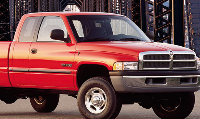fastman vs. holley
#11
says you won't indeed 'feel' a difference
with the Fastman throttle body,
in fact the graph says you will notice something,
because at every throttle position the cfm is different.
In particular at low throttle percent opening
the airflow will 'jump' faster with a straight bore.
This makes operation of the cruise control 'jumpy'
but an enthusiast might like the feel,
just like many like noisy intakes and exhausts
even when they don't give real power increases.
The Fastman also
indents the screws and
shaves the cross section of the shaft of the butterflys,
and that should help flow cfm at the wide open position
in a straightforward way.
Is is a good idea on a Ram with a stock airbox coming in straight backwards
to cut off those 'air horns' that Holley engineers out in west KY call 'flow fences' ?
F&B used to modify Chrysler throttle bodies or sell a 'billet' throttle body of their own design. Here is one of their web pages from the Internet Archive of Google:
http://web.archive.org/web/200202200...om/tbdata.html
Notice two things in the old webpage:
The dyno graph of the 740+ cfm billet throttle body shows modest gains at rpms above 3200. You would not expect much gain at all in the 1500 to 2500 rpm range where 'real world' pickups work or tow their loads.
The flow bench pictures also show you something subtle.
See how when tested on that instrument the air coming into the throttle body is allowed to come in anywhere from the 'hemisphere' above it? When tested this way, cutting off the air horns may improve cfm ..... BUT ONLY ON THE FLOW BENCH IN AN ARTIFICIAL SETUP.
In the 'real world' the throttle body has either a 90 degree plastic elbow coming straight back at it (on the Ram) or a 'air hat' coming in at what is both a sideways angle and 90 degrees (on Dakotas)
The flow fences appear to be there to guide airflow on the stock Ram airbox, and help the air 'turn the corner'.
I do admit that on Dakotas the sideways angle of the factory 'air hat' seems to be at odds with the placement of the flow fences originally put there on Magnum engines that first appeared on Rams.
Bottomline: when tested on a flow bench the Magnum throttle body SHOULD HAVE the air filter pieces bolted onto the top of it, whether that particular airbox is factory Ram, factory Dakota, KN, Volant, home-made, or whatever. That is the accurate way to see if a real improvement was made.
Notice that all the curves in the US Patent are shaped like a pulled out S ?
Draw a straight line from zero on the bottom left to the 310 cfm at top right.
That 'linear' response of the throttle opening is what an engineer would like to have.
This is one of several reasons BMW has gone to 'knife valve' throttles on each individual cylinder.
One to start your own 'garage shop' business to make some additional cash
while giving fellow Ram owners parts that provide real gains ?
Consider building 'knife valve' billet throttle bodies
They would flow even more at full opening,
and the blades would 'self clean' themselves of carbon crud
as they went in and out.
Note how the Magnum engine IAC is made, is it butterfly or knife ?



